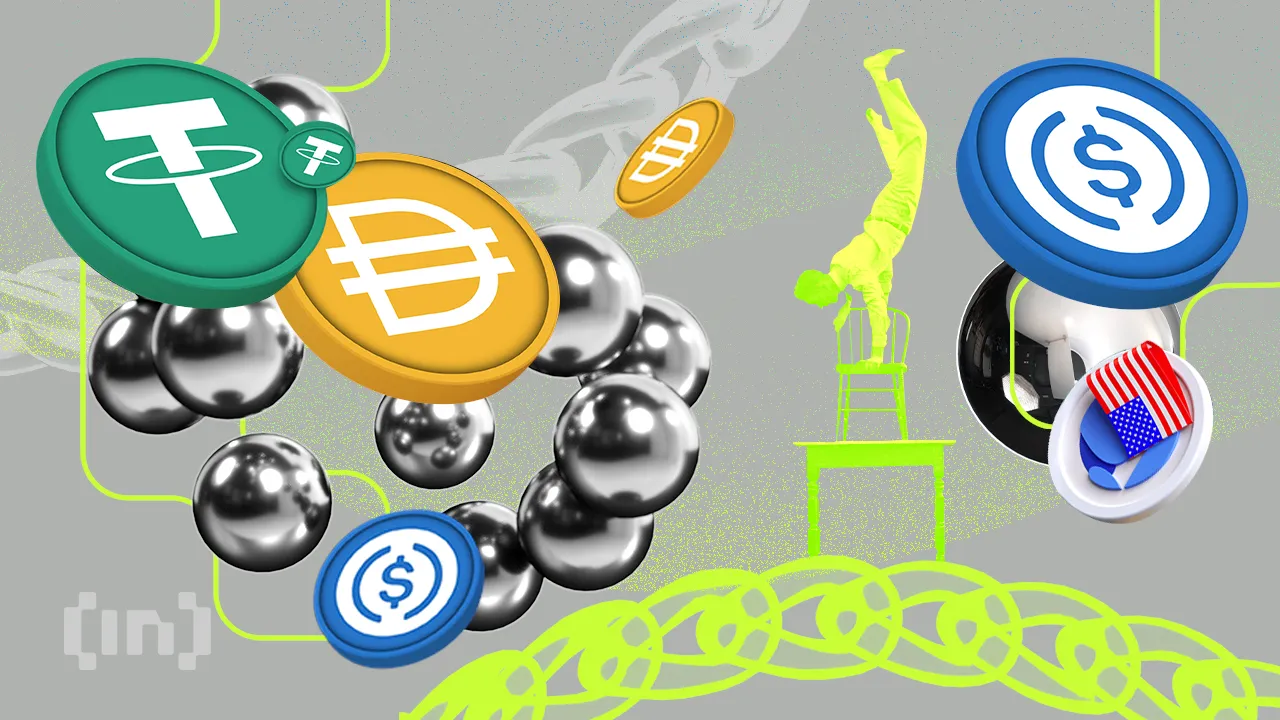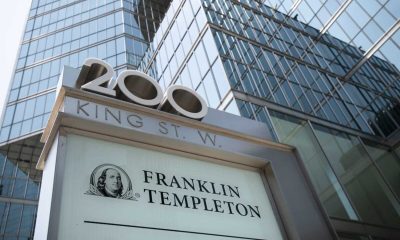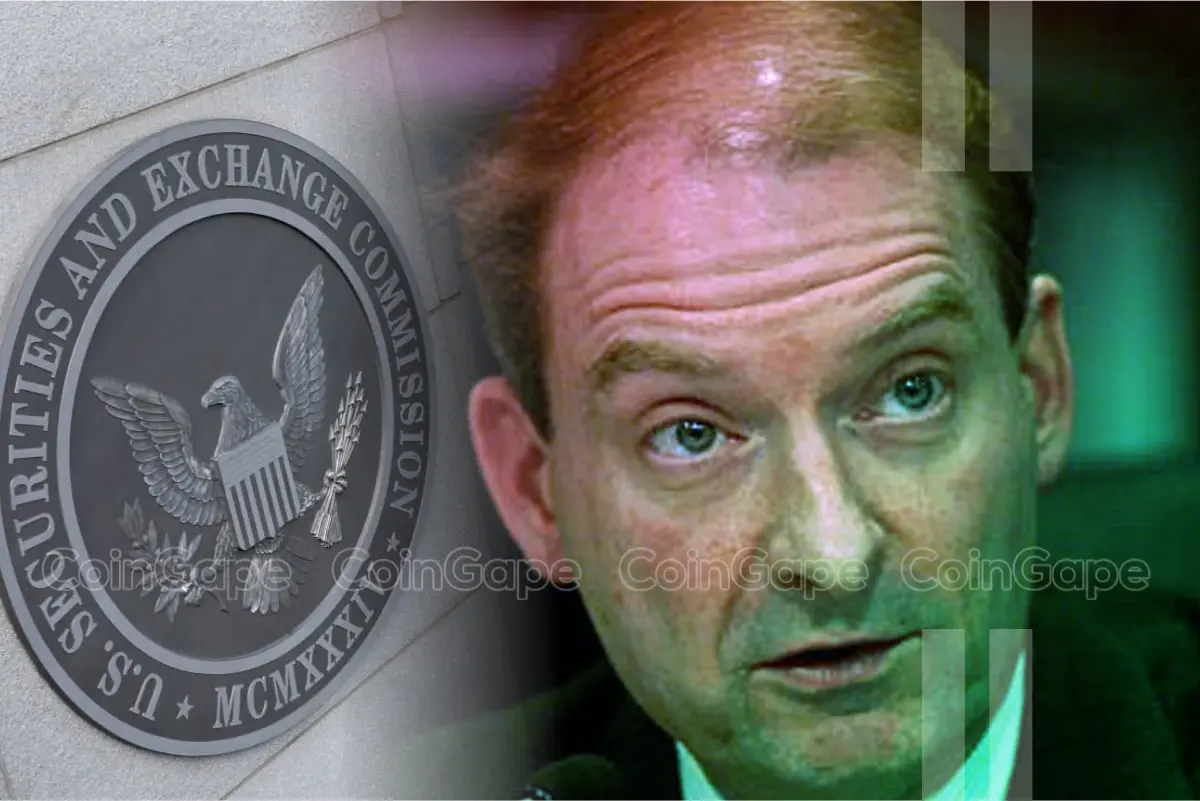Market
Trump’s USD1 Stablecoin Eyes Trust Recovery in Crypto
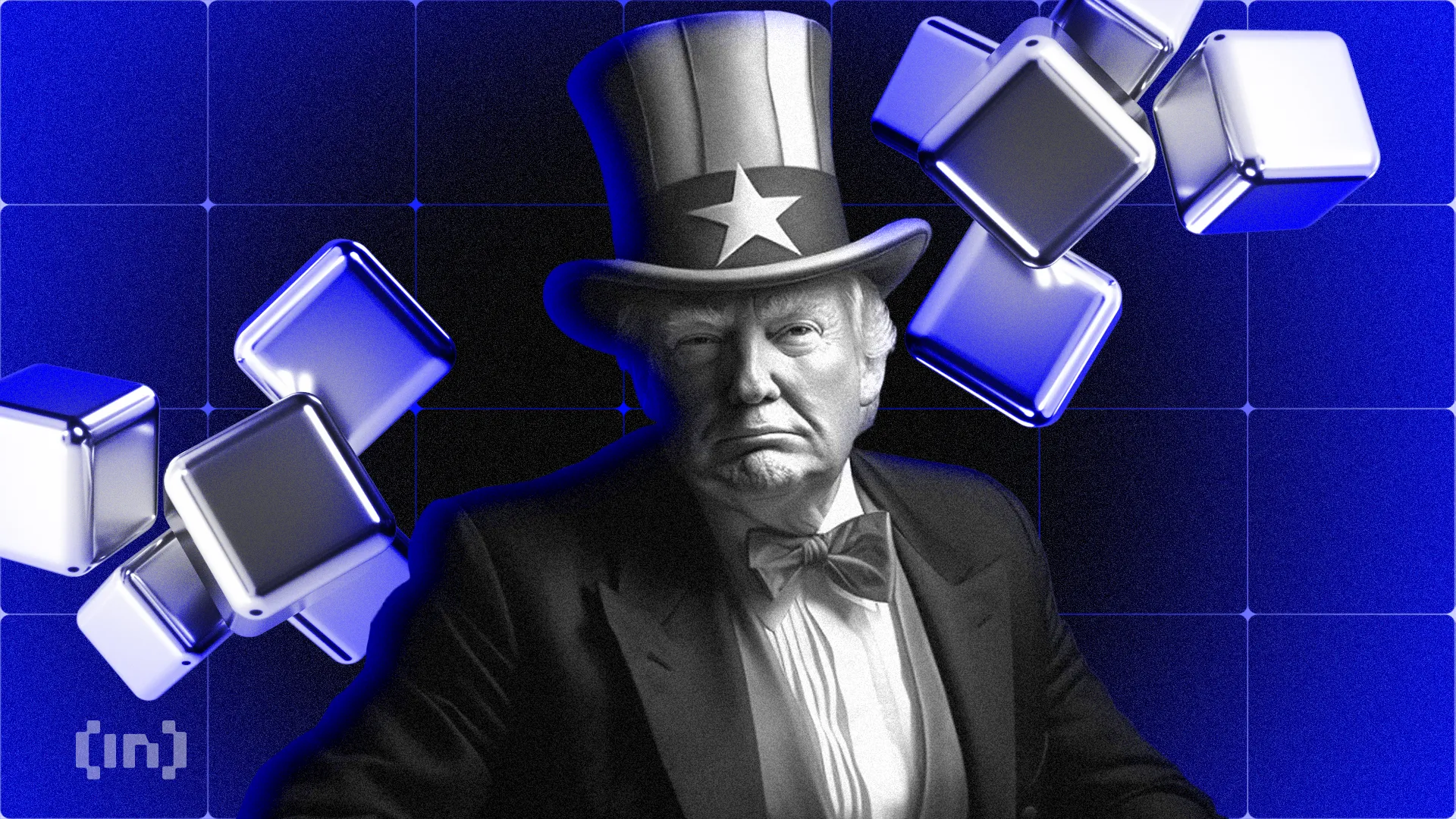
Trump made headlines again last week after World Liberty Financial announced the launch of USD1, its very own stablecoin. However, much anticipation surrounds just how successful the project will be. The launch of Trump’s meme coin at the beginning of the year resulted in billions of dollars in losses. Retail investors, in particular, have learned to be more cautious with Trump-backed endeavors.
BeInCrypto spoke with nine industry experts to learn more about USD1 and what it needs to restore public confidence in investors disappointed by Trump’s previous crypto ventures. These representatives unanimously agreed that USD1’s success hinges on transparency, proper utility, and a distinct advantage over well-established competitors.
USD1’s Promise and Trump’s Crypto History
Last week, World Liberty Financial (WLF), a token project heavily affiliated with the Trump family, officially acknowledged that it had launched USD1, its very own stablecoin. To a certain degree, the announcement was unsurprising.
During the Digital Assets Summit the White House held at the beginning of March, Treasury Secretary Scott Bessent said that the Trump administration would use stablecoins to preserve the US dollar’s role as the world’s strongest reserve currency.
USD1 aims to do exactly this. The stablecoin will be pegged to the US dollar and supported by a reserve comprised of short-term US Treasury securities, dollar deposits, and other highly liquid assets.
“Trump is not simply issuing his stablecoin. He is legitimizing stablecoins in general to support the US dollar. If you go through his stablecoin legislation, it is essentially about increasing the dollarization by making the US dollar easier and safer to use and selling more dollars in the process. Every USD stablecoin in circulation means USD-denominated asset in a bank somewhere. Not in CNY or any other currency,” Tae Oh, Founder of Creditcoin, told BeInCrypto.
But Trump’s track record in crypto has been polluted by heavy losses for retail investors and reiterated accusations of conflicts of interest. While some welcome the idea of a sitting president backing the launch of a new stablecoin, others say that it sparks further cause for trouble.
Can USD1 Redeem Trump’s Crypto Reputation?
The crypto market went berzerk when Trump launched his meme coin two days before assuming office. Within a day of trading, the token reached a market capitalization of over $14.5 billion.
But, since that moment, the meme coin has been in freefall, tainted by constant volatility and evidence of insider trading. According to Chainalysis, while early buyers were able to cash out $6.6 billion in profits, smaller traders have experienced collective losses of over $2 billion.
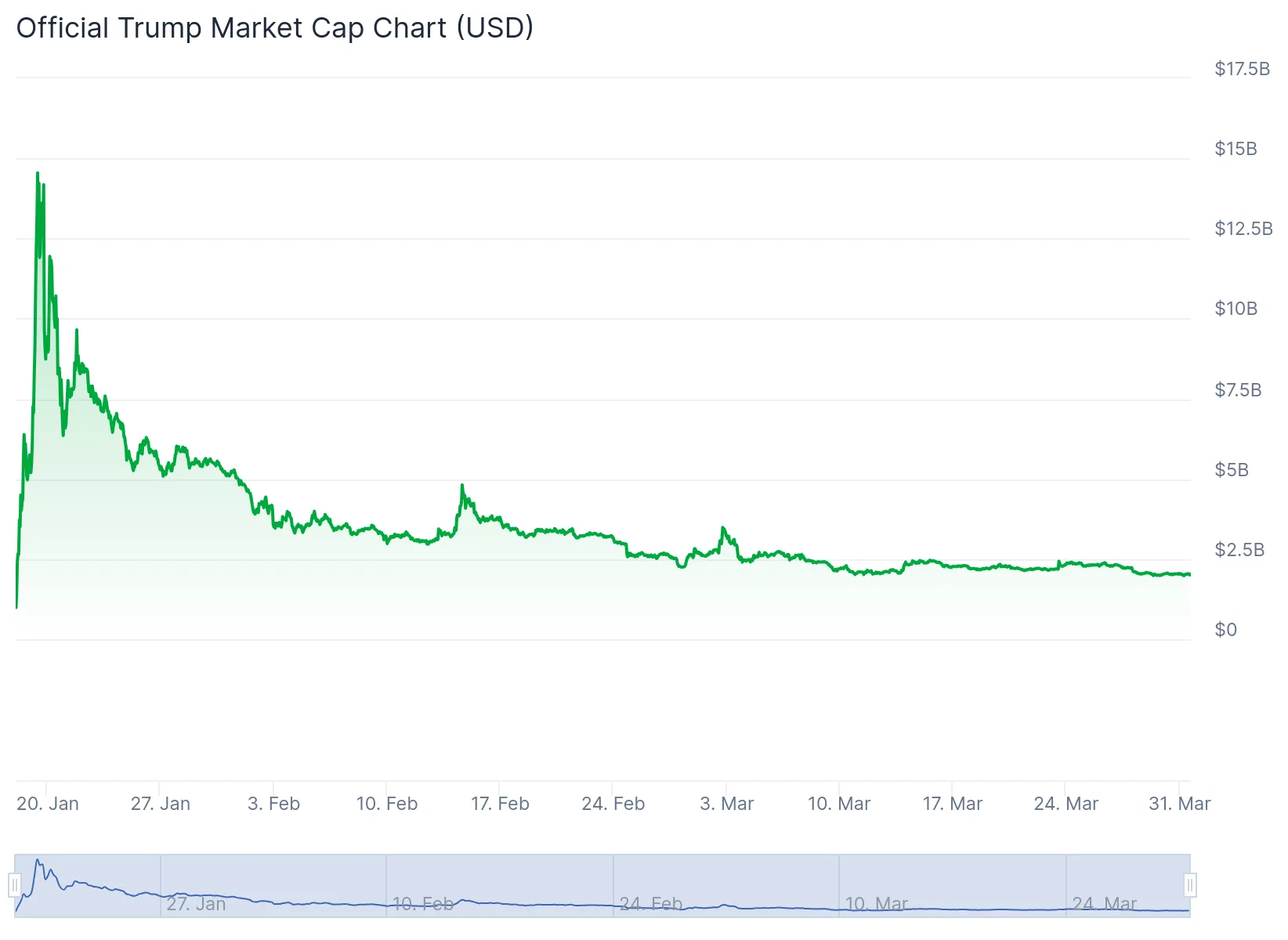
Meanwhile, the Trump family has made nearly $100 million from trading fees alone.
WLF, the President’s decentralized finance (DeFi) experiment, largely failed to restore confidence in Trump-backed crypto projects. Reports quickly unveiled that the Trump family holds a 75% stake in the platform’s net revenue and a 60% stake in the holding company.
Applying these percentages to WLF’s most recent token sale, Trump would have earned $400 million in revenue.
Now, WLF has launched USD1. Unlike meme coins, stablecoins offer investors a much higher degree of stability. Some industry leaders believe this could be Trump’s opportunity to redeem himself, while others remain doubtful. S, the pseudonymous community lead behind NEIRO, summarized it cleanly:
“If USD1 is structured well and managed transparently, it could help regain confidence, especially among newer users. But it won’t erase the impact of previous rug pulls and hype-driven projects. That healing process takes time and accountability,” he said, adding that “Authentic community engagement is now essential—it’s not enough to slap a famous name on a token.”
At the same time, the meme coin’s turbulent journey revealed Trump’s capacity to introduce newcomers to crypto, a lesson potentially applicable to USD1’s launch
Trump’s Meme Coin Impact on New Investors
TRUMP’s initial $14.5 billion market capitalization set the highest benchmark achieved by a meme coin backed by a public figure. Aside from that, according to a survey by NFTvening, 42% of TRUMP meme coin buyers were first-time crypto investors.
In other words, Trump’s meme coin project did wonders in exposing outsider investors to the cryptocurrency market. According to Oh, the same can be done with USD1– at least initially.
“The association with Trump is the strongest branding you can get in the current market. However, at the end of Trump’s term, the project needs to become disassociated from the President and more politically neutral,” he said.
Oh also added that Trump’s frequent project launches have demonstrated similarities. Though they haven’t necessarily filled a gap in the market, they have managed to onboard new users.
“I think Trump is showing us a pattern. He is legitimizing various types of cryptocurrency by issuing them himself or through his affiliate organizations. He started with memecoin and now on fiat-backed stablecoin. Is adoption the main objective of the projects? We shall see,” Oh said.
For Anthony Anzalone, CEO of XION, a Trump-backed stablecoin could create pathways for sustainable adoption compared to any meme coin.
“In the specific context of a stablecoin, Trump’s association likely provides advantages rather than disadvantages. Unlike speculative tokens, where celebrity involvement often signals short-term marketing over substance, stablecoins derive their value from stability, regulatory compliance, and institutional adoption – areas where political connections potentially confer meaningful benefits. The technical requirements and operational challenges of stablecoins are significantly different from speculative tokens, making this a more suitable venture for political backing,” Anzalone told BeInCrypto.
However, market adoption won’t exclusively hinge on presidential backing.
Will Trump’s Name Help or Hurt USD1 Adoption?
While a Trump-endorsed stablecoin could greatly increase USD1 adoption, it could also have the opposite effect.
“Trump’s polarizing presence could create skepticism, especially among those wary of political influence in financial products. While his involvement might appeal to his supporters, it risks alienating a broad portion of the market,” said Cathy Yoon, General Counsel at the Wormhole Foundation.
This risk is especially true when applied to users who believe that Trump has entered the crypto space exclusively for profit.
“Trump’s main motivation is making money from this venture, so his involvement is certainly more likely to be a downside than an advantage. You know he’ll try everything to suck as much profit out of this venture as possible, and it could be at the expense of the end user,” Jean Rausis, Co-founder of SMARDEX, told BeInCrypto.
The fact that WLF, a Trump-backed project associated with several conflicts of interest, launched USD1 does little to assuage skeptics about future risks.
Conflicts of Interest and USD1 Transparency
Trump failed to prevent similar accusations of conflicts of interest by directly associating himself with the USD1 launch through WLF.
“A conflict of interest arises when the current US President is also a key figure in World Liberty Financial. He will be closely monitored and face regulatory hurdles to ensure there is no manipulation of the financial system, but this alone could deter investors when there are highly competitive and much more mature products in that market,” Vivien Lin, Chief Product Officer at BingX, told BeInCrypto.
Suppose Trump wants to distance himself from the criticism his previous projects received. In that case, he will have to ensure that USD1 adheres to transparency mechanisms and regular audits—not only for public trust but also to ensure that the sitting President doesn’t break the law.
“Transparency should be at the forefront of all communications, especially with Trump’s involvement as the US President and stakeholder in World Liberty Financial. This situation could violate the Constitution’s emoluments clause, which broadly refers to any advantage, profit, or gain received due to holding office. If violated, this could significantly hurt the public’s trust. Another aspect that should be considered is establishing safeguards against potential market manipulation, especially given WLFI’s history of large crypto purchases before important events to prevent market manipulation,” Lin added.
USD1’s success will also largely depend on its execution.
USD1’s Path in a Competitive Market
Stablecoins have existed since 2014 and are finding a permanent home in the broader market. According to the World Economic Forum, the current supply of stablecoins in circulation exceeds $208 billion.

With a market capitalization approaching $144 billion, Tether (USDT) is today’s most dominant stablecoin. In second place comes Circle’s USDC, with a market capitalization of over $60 billion. Driven by their dollar peg and perceived inflation hedge, stablecoins have become highly popular, prompting increased stablecoin launches from banks and tech firms.
“The more we see responsible innovation that includes utility use cases– such as prudentially regulated stablecoins for global payment processing – the more crypto’s reputation will solidify and credibility will grow. I don’t think we need to rely or wait for one product such as USD1. The momentum has been building and will continue,” Beth Haddock, Global Policy Lead at Stablecoin Standard, told BeInCrypto.
USD1 must set itself apart to succeed in an already cutthroat market.
“If USD1 lacks interoperability, has limited on/off-ramps, or fails to differentiate from incumbents like USDC or USDT, it risks being relegated to a niche use case. Ultimately, mainstream success will come down to execution, partnerships, and solving real user pain points—especially in markets where traditional financial access is limited or inefficient,” said Mouloukou Sanoh, CEO of MANSA.
According to Martins Benkitis, CEO of Gravity Team, catering to niche markets isn’t a bad idea. But in an already competitive field, it might not be enough.
“If it becomes a gateway for on-chain political donations or movement-aligned payments, it’s filling a niche. The question is whether that niche is big enough to sustain a stablecoin. Jury’s still out, but it’s an angle,” he said.
Inevitably, providing some utility that is not currently available will factor into USD1’s eventual success.
What Utility Will USD1 Offer?
What USD1 can offer the market boils down to what Trump has in store. Several details regarding its launch have yet to be released.
Nonetheless, if executed properly, the stablecoin has the potential to offer a degree of stability and predictability that TRUMP’s meme coin was unable to deliver. It could also give the President the golden opportunity to restore the trust that he lost from his previous crypto ventures.
If this is among Trump’s matters of concern for USD1, he will have to prioritize factors like transparency, security, and clear utility. These will be the aspects the public will be looking out for.
Disclaimer
Following the Trust Project guidelines, this feature article presents opinions and perspectives from industry experts or individuals. BeInCrypto is dedicated to transparent reporting, but the views expressed in this article do not necessarily reflect those of BeInCrypto or its staff. Readers should verify information independently and consult with a professional before making decisions based on this content. Please note that our Terms and Conditions, Privacy Policy, and Disclaimers have been updated.
Market
TRUMP Token Hits Record Low Due To Liberation Day Tariffs
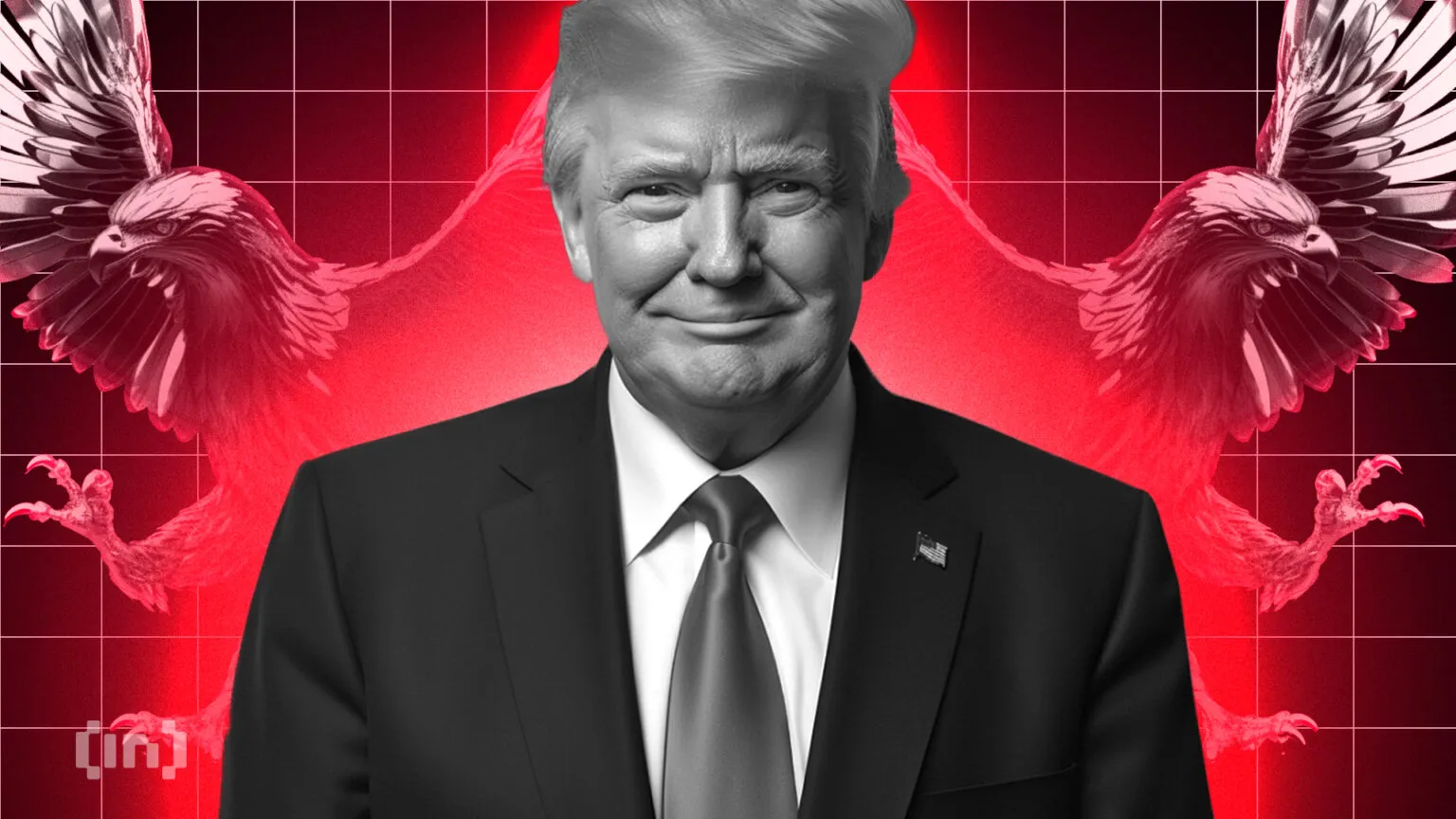
TRUMP token has faced a significant downturn, failing to recover after a recent decline. The altcoin’s price has been further pressured by the announcement of US President Donald Trump’s Liberation Day Tariffs.
As a result, bearish sentiment has grown, leading traders to capitalize on the negative market conditions.
Trump’s Announcement Took A Toll
The funding rate for TRUMP turned negative over the last 24 hours, signaling increased bearish activity. Traders are shifting to short contracts, betting that the price will decline further. This shift in sentiment follows the announcement of the tariffs, which, despite being a policy move, had a negative impact on TRUMP’s price.
This negative market reaction highlights traders’ skepticism about the future prospects of TRUMP. While the tariff announcement was meant to stimulate market reactions, it instead spurred fear, driving a wave of sell-offs.

Looking at the broader momentum, technical indicators such as the Relative Strength Index (RSI) reveal that TRUMP is far from recovering its recent losses. The RSI remains firmly in the bearish zone, well below the neutral 50.0 mark. With no signs of reversal or bullish momentum, the token is likely to continue facing declines in the short term.
The oversold conditions are not yet reached either, indicating there is still room for further declines. With the RSI not showing any substantial recovery signals, the current downtrend could persist until market sentiment shifts or a new catalyst sparks renewed interest in the token.

TRUMP Price Suffers
TRUMP’s price hit a new all-time low of $8.97 before recovering slightly to $9.29. Over the last 24 hours, the token has seen a 10% decline. This drop has added to its month-long 45% slide, as the token lost crucial support levels, including $12.57 and $10.29.
The ongoing bearish trend suggests that TRUMP could continue to slide, with the next key support around $8.00. If the broader market conditions remain weak and the bearish sentiment continues to dominate, the price could dip further, reaching new lows before any potential recovery.
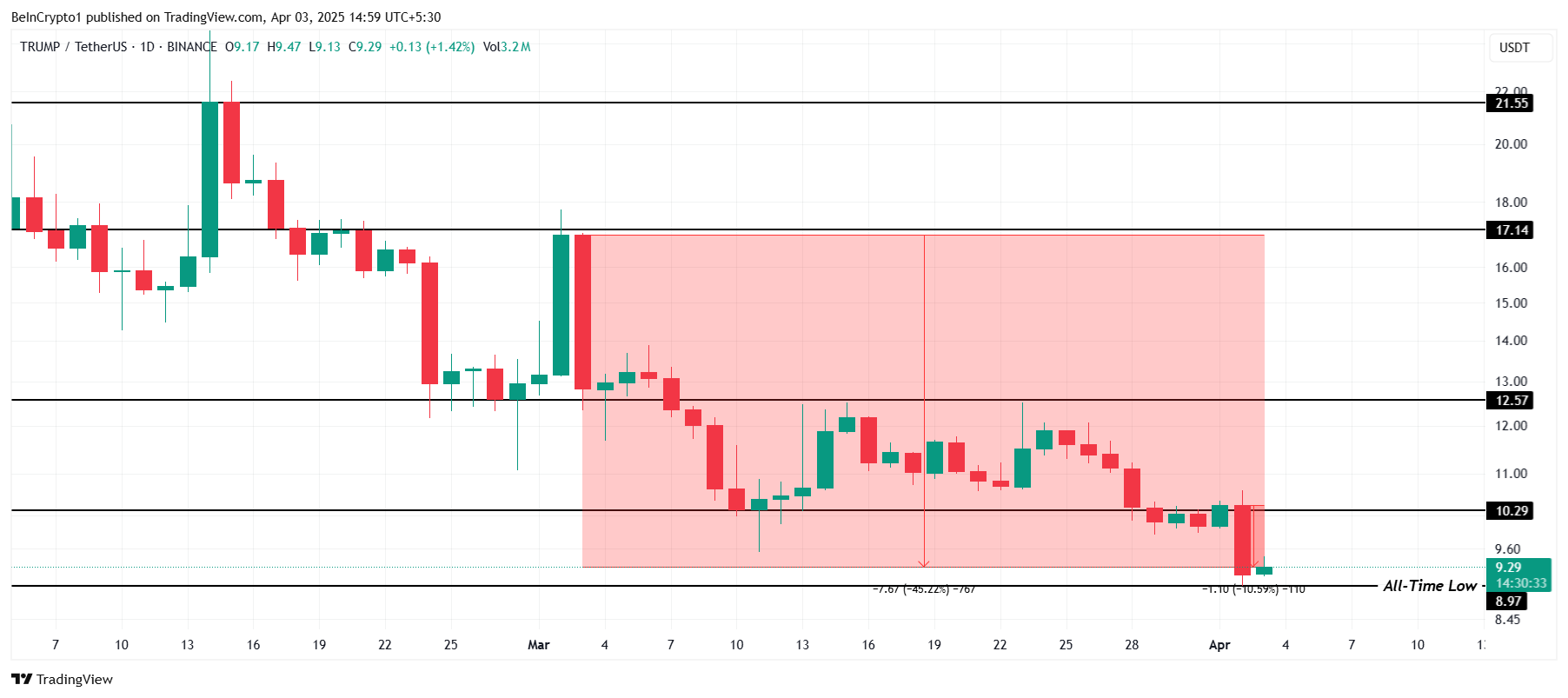
However, if TRUMP manages to reclaim $10.29 as support, it could mark the beginning of a recovery attempt. Successfully breaching $12.57 could invalidate the current bearish outlook and signal a potential rally, but this would require a significant shift in investor sentiment and market conditions.
Disclaimer
In line with the Trust Project guidelines, this price analysis article is for informational purposes only and should not be considered financial or investment advice. BeInCrypto is committed to accurate, unbiased reporting, but market conditions are subject to change without notice. Always conduct your own research and consult with a professional before making any financial decisions. Please note that our Terms and Conditions, Privacy Policy, and Disclaimers have been updated.
Market
Bitcoin’s Future After Trump Tariffs

Welcome to the US Morning Crypto Briefing—your essential rundown of the most important developments in crypto for the day ahead.
Grab a coffee to see how Bitcoin is holding its ground while Wall Street stumbles, why Trump’s tariffs may push the Fed into money-printing mode, and what that could mean for crypto’s next chapter. From Ethereum’s test of resilience to rising odds of a US recession, here’s everything you need to know to stay ahead.
Bitcoin Enters Its Risk-Dynamic Era Amid Tariffs and Turmoil
Bitcoin’s reaction to recent macro shocks—particularly Trump’s sweeping tariffs—has been noticeably calm compared to traditional markets, and that’s turning heads. While Wall Street stumbles harder than expected, crypto has held relatively steady.
Nexo Dispatch Editor Stella Zlatarev told BeInCrypto that this isn’t just resilience—it’s evidence that Bitcoin may be entering a new phase of market maturity.
“A 2–3% drop in crypto is a rounding error compared to past cycles,” she said, emphasizing that this stability amid chaos suggests Bitcoin is no longer just a speculative punt. “Bitcoin’s ability to weather macro turbulence without the wild swings of previous years suggests institutional investors are treating it less as a speculative punt and more as a strategic asset,” Zlatarev said.
Analysts also stressed that Bitcoin’s behavior doesn’t align with traditional asset categories.
“It’s not gold, and it’s not the yen. Instead, Bitcoin is emerging as a risk-dynamic asset – one that doesn’t crumble like high-growth stocks but also doesn’t attract the same flight-to-safety flows as traditional safe havens,” Zlatarev told BeInCrypto.
This concept of a “risk-dynamic” asset positions Bitcoin in a unique role: something that thrives in uncertainty but doesn’t collapse when the market turns.
Zlatarev from Nexo also noted that how Ethereum and other blue-chip altcoins respond next will be key.
“If ETH mirrors BTC’s performance, it strengthens the case that top-tier crypto assets are evolving into a more predictable asset class. If ETH wobbles, it reinforces that, for now, Bitcoin is in a league of its own.”
Meanwhile, the macro backdrop is shifting fast. Trump’s new “Liberation Day” tariffs have spooked global trade partners and have also sent ripple effects through prediction markets. Polymarket now gives almost 50% odds of a US recession this year—a major shift following the announcement.
Also, CME FedWatch tool shows interest rate traders have boosted the probability the US Federal Reserve will make four rate cuts this year. Eventually, this could relief the current macroeconomic pressure on Bitcoin.

Former BitMex CEO Arthur Hayes mentioned that Trump’s current tariff strategy could complicate the US bond market. In other words, pressure is building for the Fed to intervene—possibly by turning on the liquidity spigot once again.
All of this puts Bitcoin in a new spotlight. Its steadiness is no longer being dismissed as a coincidence. It may be the first sign that crypto, or at least its most mature players, is stepping out of the shadows of speculation and into the spotlight of strategic finance.
Chart of the Day
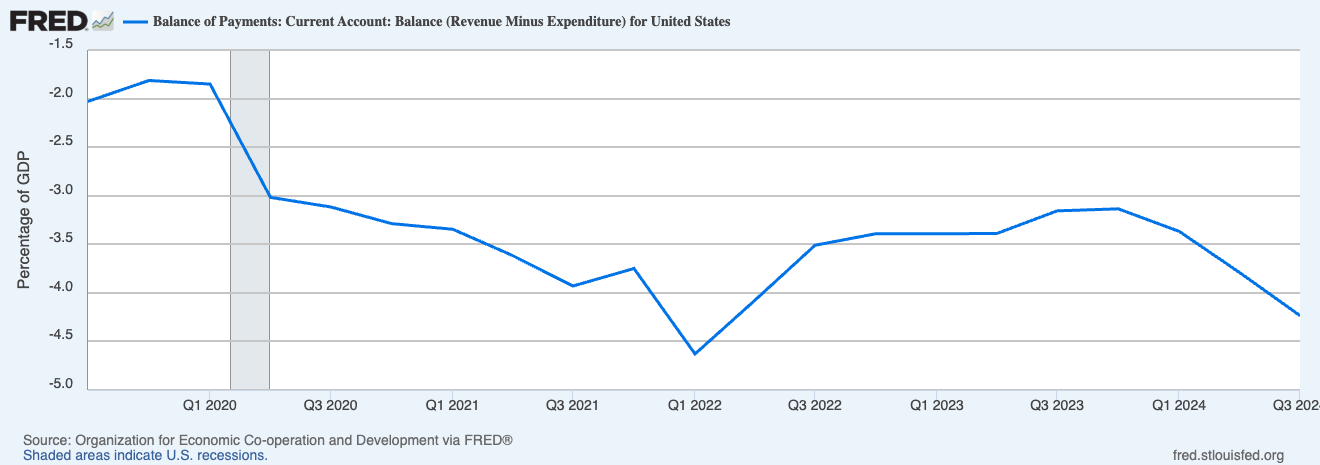
By reducing foreign demand for US Treasuries, Trump’s tariffs may force the Fed to inject more liquidity—potentially weakening the dollar and boosting Bitcoin as an alternative store of value.
Byte-Sized Alpha
– Trump’s “Liberation Day” enforces 10%+ tariffs on all imports, hitting China, the EU, and Israel, triggering market drops and recession fears.
– According to Standard Chartered, Bitcoin may hit $500,000 by Trump’s term end, AVAX could 10x by 2029, and Ethereum’s 2025 target drops to $4,000.
– The STABLE Act of 2025 advances with bipartisan support, aiming to tighten stablecoin rules as competition and regulatory pressure intensify.
– Bitcoin ETFs see $221 million in April inflows led by ARKB, but BTC derivatives cool with falling futures interest and bearish options sentiment.
– DXY hits a 2024 low after “Liberation Day” tariffs, fueling short-term Bitcoin surge hopes amid global tensions and policy uncertainty.
– Bitcoin struggles below $85,000 amid weak sentiment, but long-term holders stay firm, keeping capitulation fears at bay.
– Polymarket sees almost 50% chance of US recession as Trump’s tariffs spark market fears and trade tensions.
Disclaimer
In line with the Trust Project guidelines, this price analysis article is for informational purposes only and should not be considered financial or investment advice. BeInCrypto is committed to accurate, unbiased reporting, but market conditions are subject to change without notice. Always conduct your own research and consult with a professional before making any financial decisions. Please note that our Terms and Conditions, Privacy Policy, and Disclaimers have been updated.
Market
EDGE Goes Live, RSR Added to Roadmap

Coinbase, one of the leading cryptocurrency exchanges, has announced the addition of Reserve Rights (RSR) to its listing roadmap, signaling a strategic move to broaden its offerings.
This coincides with the exchange’s decision to list Definitive (EDGE), which has already sparked significant market activity.
Coinbase Adds RSR To Roadmap
Reserve Rights is an ERC-20 token native to the Reserve Protocol. The platform offers a permissionless decentralized framework for stablecoin development. It enables users to create yield-bearing, asset-backed, and overcollateralized stablecoins on the Ethereum (ETH) blockchain.
The addition of RSR to Coinbase’s listing roadmap has caught considerable attention, partly due to its association with Paul Atkins, President Donald Trump’s nominee for SEC Chair.
Atkins previously served as a crypto advisor for the Reserve Protocol. He is widely regarded as a crypto-friendly figure—standing in sharp contrast to his predecessor, Gary Gensler, who oversaw a stringent crackdown on the industry during his tenure.
Notably, the exchange’s move was celebrated by the platform.
“Great to see more opportunities for people to participate in the Reserve ecosystem,” Reserve Protocol posted on X (formerly Twitter).
Despite the development, RSR’s price has shown only modest movement.

According to the latest data, it was trading at $0.006. This reflected a 1.2% increase over the past 24 hours.
However, the token has gained strong community support. CoinMarketCap data showed a 91.6% bullish sentiment among users. This indicated increased user confidence in its potential.

EDGE Sees Triple-Digit Rally Post Coinbase Listing
While RSR’s price showed only small gains, the EDGE token’s reaction has been much more dramatic. Coinbase revealed via X that it would list the Definitive platform’s utility token, EDGE.
“Trading will begin later today if liquidity conditions are met. Once sufficient supply of this asset is established trading on our EDGE-USD trading pair will launch in phases. Support for EDGE may be restricted in some supported jurisdictions,” the announcement read.
Following this, EDGE saw its price surge by an impressive 120.6% to $0.091. Previously, a similar reaction was observed in Doginme (DOGINME) and Keyboard Cat (KEYCAT) after they secured a listing on the exchange.

EDGE’s listing, however, comes with an “Experimental” label. This is a designation Coinbase uses to indicate assets that may carry higher risk or volatility.
“The Experimental asset label will not impact your ability to send, receive, buy, sell and/or hold assets on Coinbase. However, we do ask you to read and confirm you understand the risks involved, such as price swings and canceled orders, before trading an experimental asset for the first time,” the blog reads.
As Coinbase continues diversifying its portfolio, the addition of RSR and EDGE highlights the growing acceptance of diverse blockchain projects. These listings may provide new opportunities for investors. However, the associated risks should be carefully considered.
Disclaimer
In adherence to the Trust Project guidelines, BeInCrypto is committed to unbiased, transparent reporting. This news article aims to provide accurate, timely information. However, readers are advised to verify facts independently and consult with a professional before making any decisions based on this content. Please note that our Terms and Conditions, Privacy Policy, and Disclaimers have been updated.
-

 Altcoin22 hours ago
Altcoin22 hours agoHere’s Why This Analyst Believes XRP Price Could Surge 44x
-

 Ethereum22 hours ago
Ethereum22 hours agoWhales Dump 760,000 Ethereum in Two Weeks — Is More Selling Ahead?
-

 Ethereum20 hours ago
Ethereum20 hours agoWhy A Massive Drop To $1,400 Could Rock The Underperformer
-

 Altcoin18 hours ago
Altcoin18 hours agoFirst Digital Trust Denies Justin Sun’s Allegations, Claims Full Solvency
-

 Altcoin21 hours ago
Altcoin21 hours agoHow Will Elon Musk Leaving DOGE Impact Dogecoin Price?
-

 Altcoin19 hours ago
Altcoin19 hours agoWill Cardano Price Bounce Back to $0.70 or Crash to $0.60?
-

 Market11 hours ago
Market11 hours agoXRP Price Under Pressure—New Lows Signal More Trouble Ahead
-

 Altcoin11 hours ago
Altcoin11 hours agoAnalyst Forecasts 250% Dogecoin Price Rally If This Level Holds






